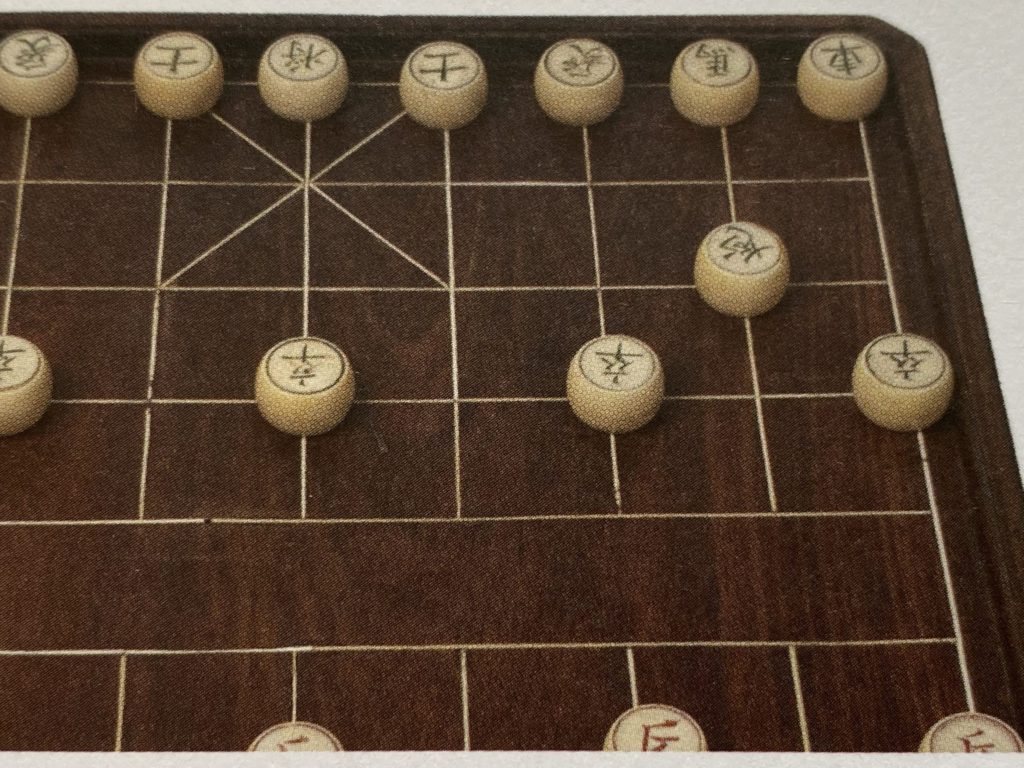Xiang Q'I
Xiang Q’I is a Chinese version of chess. It is played on a board of nine by ten lines. The pieces do not move within the squares but on the points or intersections of the lines. There are some similarities that suggest that the games chess and Xiang Q’I did, at some time in their early history, cross-pollinate, as both games have, or have had, generals, (knight) mandarins (queen) elephants (bishop) horses (knight) chariots (rook) soldiers (pawn). The aim of Xiang Q’I is to checkmate the opposing general (source: Williams Master Pieces).
In the Chinese Xiang Q’I, thirty-two suitably engraved wood or ivory discs were used upon a board subdivided into sixty-four squares. The board is divided into two halves by a river or trench, called hoa-ki, and the two centre squares of the rear rank were linked together and to the two squares immediately in front of them in the second rank to form a fortress in which the king and his two counsellors moved. The chess pieces were positioned on the dividing lines and did not occupy the squares. The names of the pieces included the following. The Chong (king or general) stands at the centre of the rear rank, and moved one step in all directions, but is confined to the limits of his fortress. The Sou (prince or counsellor) includes two pieces. A Sou stands besides the Chong and has similar moves and limits. A Tchong(mandarin or elephant) also come two in number. A tchong stands next to each sou. He moves two steps at a a time, forward or backward, but cannot advance across the river. A Mai(horse) is also coming in two pieces per side. A mai stands next to each tchong. He has precisely the same moves as a knight in medieval chess, but cannot cross the river. A Tche (chariot) – also coming with two pieces – stands next to each mai at the outer edge of the board. He has exactly the same moves as the rook in medieval chess, and can cross the river. A Pao (rocket boy or mortar), two for each side, stands in front of each mai on the next line but one. A pao moves across the entire board; forward, backwards, and to either side. If an opponent’s piece intervenes in a direct line, a pao captures the piece immediately behind it. A Ping (pawn or foot soldier) – five in number – stands in lines on the third rank. They move one step at a time forward, but capture sideways. They may cross the river, but there is no promotion on reaching the final rank.
The pieces for the Chinese game are in the shape of simple discs, as used in checkers, but with the name of each piece inscribed on either side, usually coloured red opposed to blue.

Xiang Q’i Chessmen
Chinese chessmen in wooden box. Made out of ivory. Diameter of pieces : 3cm. Source: CCI (2012) Chinese Chess Sets.

Xiang Q’i Chessmen
Chessmen for Chinese chess. Ivory. Diameter of the pieces is 2.9cm. Height 1.8cm. Source: CCI (2012) Chinese Chess Sets.

Board for Chinese chess
Wooden board, inlaid with ivory. 19th century. Dimensions are 40×46.5cm. Source: CCI (2012) Chinese Chess Sets.

Folding Board for Chinese chess
Wooden board, Dimensions are 32.5x37cm. Octagonal chessmen for Korean Chess. Korea, wood. Source: CCI (2012) Chinese Chess Sets.

Folding Board
Folding board with decorated hinge for Chinese chess. Wood. Dimensions 41.5×47.5cm. Source: CCI (2012) Chinese Chess Sets.

Porcelain chess set
Chessmen in porcelain; porcelain board probably produced later. Pieces with diameter 2.8cm. Board 29.5cmx33cm. Source: CCI (2012) Chinese Chess Sets.